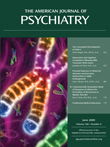In This Issue
Prenatal Infection and Schizophrenia
Infection with influenza or toxoplasma in pregnant women was associated with cognitive dysfunction among grown offspring with schizophrenia. Prenatal infections were serologically documented in serum samples collected from 12,094 pregnant women in 1959–1966. In the 26 available adult offspring with schizophrenia-related disorders, Brown et al. (CME, p. Original article: 683 ) measured several aspects of executive functioning , i.e., the ability to reason and generate adaptive behaviors. Those who had been exposed to either infection during gestation performed more poorly than nonexposed offspring with schizophrenia on tests of attention, psychomotor speed, mental flexibility, and fluency of visual-spatial thinking.

Cognitive Effects of Antipsychotic Drugs
A comparison of one older antipsychotic medication and four second-generation antipsychotics indicated that they all improved cognition moderately in patients with first-episode schizophrenia or schizophreniform disorder. The amount of improvement did not differ among drugs and correlated only weakly with change in psychotic symptoms. In the open-label study by Davidson et al. (p. Original article: 675 ), 286 patients completed cognitive tests at baseline and after a 6-month trial of haloperidol—the first-generation antipsychotic—or amisulpride, olanzapine, quetiapine, or ziprasidone. To help clarify previous equivocal findings, the study enrolled only patients with minimal or no previous exposure to antipsychotics, encompassed a relatively wide range of patients, allowed dose adjustments, and included the most commonly prescribed first-generation antipsychotic, haloperidol, at a low dose to avoid anticholinergic drugs. Terry Goldberg and Jesus Gomar offer perspective on this research in an editorial on p. Original article: 631 .
Paliperidone for Acute Schizophrenia
Extended-release paliperidone reduced psychotic symptoms more quickly than quetiapine or placebo in 399 patients hospitalized for acute exacerbations of schizophrenia. Canuso et al. (p. Original article: 691 ) observed superiority over placebo at day 5 with paliperidone and at day 9 with quetiapine. Paliperidone maintained its advantage over placebo at 2 weeks and at study end point, but quetiapine did not. Over the 6-week comparison, patients taking paliperidone were more likely to have extrapyramidal symptoms or hyperprolactinemia, and those taking quetiapine gained more weight. The overall rates of discontinuation were 21.5% for paliperidone, 33.3% for quetiapine, and 36.3% for placebo. Drs. Robert Hamer and Pippa Simpson examine statistical issues in the analysis of the results of the study in an editorial on p. Original article: 639 .
Reward Processing in Depression
Monetary gains elicited weaker responses in the left nucleus accumbens and bilateral caudate of unmedicated patients with major depressive disorder than in comparison subjects. Pizzagalli et al. (p. Original article: 702 ) examined both anticipatory and achievement phases of reward processing by measuring responses in the basal ganglia to cues indicating potential reward and to actual outcomes. Differences between groups during reward anticipation were less evident than those following actual rewards, although the patients did have a smaller response to reward cues in a small area of the left posterior putamen. Within the depressed group, ratings of anhedonia and overall depression were inversely correlated with the bilateral volume of the caudate.
Inheritance of ADHD Behavioral Marker
Difficulty in inhibiting motor responses in children with attention deficit hyperactivity disorder (ADHD) is shared by their parents, particularly fathers. This finding by Goos et al. (p. Original article: 711 ) adds to evidence that deficient inhibitory control could be used to select subjects for genetic research in ADHD, which has suffered from possible heterogeneity among patients with the ADHD diagnosis. A task measuring inhibitory control was performed by children with ADHD, their parents, and healthy children and adults. The parents’ reaction time was significantly related to the children’s time, regardless of symptom severity in either generation. An analysis of reaction times indicated that inhibitory control in fathers, but not mothers, was associated with inhibition in children of both sexes, a difference which indicates a possible parent of origin genetic effect.



